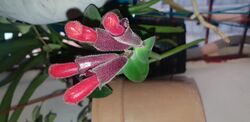Biology:Aeschynanthus pulcher
| Aeschynanthus pulcher | |
|---|---|

| |
| Scientific classification | |
| Kingdom: | Plantae |
| Clade: | Tracheophytes |
| Clade: | Angiosperms |
| Clade: | Eudicots |
| Clade: | Asterids |
| Order: | Lamiales |
| Family: | Gesneriaceae |
| Genus: | Aeschynanthus |
| Species: | A. pulcher
|
| Binomial name | |
| Aeschynanthus pulcher | |
| Synonyms[1] | |
| |
Aeschynanthus pulcher, the lipstick plant or red bugle vine, is a species of evergreen perennial plant in the family Gesneriaceae, native to Indochina and western Malesia.[2] An epiphytic climber, it produces clusters of red flowers from summer to winter.[3] The common name "lipstick plant" refers to the bright red tubular flowers, about 6 cm long,[4] that emerge from a maroon calyx, which resemble lipstick emerging from a tube.[5] The plant may grow 60 cm to 2 meters tall, with an average spread of 50 cm.[4] The leaves are elliptic and are arranged in pairs, with smooth edges.[6]
The specific epithet pulcher means "pretty" or "beautiful", referring to the brilliant red blooms.[7]
With a minimum temperature of 15–18 °C (59–64 °F),[3] A. pulcher is grown as a houseplant in temperate regions. It is particularly suitable for hanging baskets. It requires bright light but not direct sunlight, does best in humid conditions, and should be potted in a porous, acidic medium.[8] It has gained the Royal Horticultural Society's Award of Garden Merit.[9] It has heavy, succulent-like leaves and the soil should be allowed to dry out between waterings.[5] Common pests include aphids and mealybugs.[4]
Gallery
References
- ↑ The Plant List: A Working List of All Plant Species, http://www.theplantlist.org/tpl1.1/record/kew-2623960, retrieved 1 April 2017
- ↑ Middleton D.J. 2007. A revision of Aeschynanthus (Gesneriaceae) in Thailand. Edinburgh Journal of Botany 64 (3): 363–429
- ↑ 3.0 3.1 RHS A-Z encyclopedia of garden plants. United Kingdom: Dorling Kindersley. 2008. pp. 65. ISBN 978-1405332965.
- ↑ 4.0 4.1 4.2 "Lipstick Plant (Aeschynanthus pulcher) - Plants | Candide Gardening" (in en-GB). https://candidegardening.com/GB/plants/f15e5d6d-d210-4cb0-a984-dc520325c03b.
- ↑ 5.0 5.1 "Aeschynanthus pulcher | Gesneriad Reference Web" (in en-US). https://gesneriads.info/genera/aeschynanthus-pulcher-2/.
- ↑ "Aeschynanthus pulcher". April 20, 2020. https://www.nparks.gov.sg/florafaunaweb/flora/1/2/1298.
- ↑ Harrison, Lorraine (2012). RHS Latin for gardeners. United Kingdom: Mitchell Beazley. pp. 224. ISBN 9781845337315.
- ↑ Chiusoli, Alessandro; Boriani, Luisa Maria (1986). Simon & Schuster's guide to houseplants. New York: Simon and Schuster. ISBN 0671631314.
- ↑ "RHS Plant Selector - Aeschynanthus pulcher". https://www.rhs.org.uk/Plants/560/Aeschynanthus-pulcher/Details. Retrieved 23 February 2020.
Wikidata ☰ Q4688540 entry
 |




